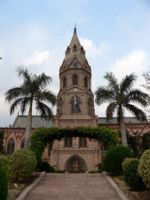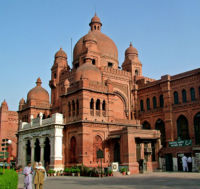Lahore
| Lahore | |
|---|---|
| [[Image:|250px| ]] | |
| Presidency: Bengal | |
| Coordinates: | 31.545073°N 74.340835°E |
| Altitude: | 217 m (712 ft) |
| Present Day Details | |
| Place Name: | Lahore |
| State/Province: | Punjab |
| Country: | Pakistan |
| Transport links | |
Lahore was the capital of undivided Punjab until Partition in 1947, after which it became the capital of West Punjab in Pakistan.
History
Churches
Anglican
- Lahore Cathedral (Cathedral Church of Resurrection) - consecrated in 1887
- St Andrew's (The Railway Church) - built in 1899 to serve the Railway colony, near the North Western Railway Headquarters
- St Anthony's - also near the North Western Railway Headquarters on Empress Road
Roman Catholic
- Cathedral of the Immaculate Conception - built 1861
- Sacred Heart Cathedral - consecrated 1907, the seat of the Diocese of Lahore
Education
Schools
- Convent of Jesus and Mary
- Queen Mary College
Colleges/University

- Government College (now University) (1864)
- Islamia College
- King Edward Medical College (now University)
- University of Punjab
Health
Hospitals
- Lady Aitchison Hospital
- Mayo Hospital (1871)
- Sir Ganga Ram Hospital (1921)
Dispensaries
Cemeteries
Commercial
Banks
- The Australasia Bank (1942)
- Punjab National Bank (1895)
Buildings
- Lawrence Hall (now part of Quaid-e-Azam Library) Photograph
- Montgomery Hall (now part of Quaid-e-Azam Library)
Military
The Cantonment was situated 3 miles east of the civil station of Lahore and until 1906 was known as Mian Mir (alternative spelling Mean Meer, Meean Meer)
Lahore was the head-quarters of the Punjab Light Horse and of the 1st Punjab Volunteer Rifles.[1] "A Beleagured City",is a parody by Rudyard Kipling about the proximity of the firing range of the Punjab Volunteer Rifles to the Lawrence Hall Gardens
Transport
Railways
- Lahore Railway Station
Lahore was the headquarters of North Western Railway. There were railway workshops and a railway colony.
Places of interest

- Walled City of Lahore
- Lahore Museum. The Mall
- Lahore Zoo (1872) The Mall. official website
- Maryam Zamani (Begum shahi) Mosque (near Fort)
- Nawab Bahadur Khan's tomb. (used as a theater hall during the early period)[2]
- Mahabat Khan's tomb and Boundary Wall, Baghbanpura (near Shalimar Gardens)
- Prince Perwaiz's tomb. Chah Miran area.
- Wazir Khan's Hammam
- Wazir Khan's Baradari (served as soldier's quarters until cantonment shifted to Mian Mir.) Behind Lahore Museum.[3]
- Zamzama Gun (Kim's Gun)
Protected Monuments
[[Image:Lahore_Qutbuddin_Aibak_Mausoleum.jpg|thumb|200px|Qutbuddin Aibak's Tomb (2009) The following are historical monuments protected during this era. The year is brackets is the year of their notification.
- Akbari Sarai and Mosque (1911)
- Anarkali's Tomb (1924) (serves at the Punjab Records Office since 1891) in Punjab Civil Secretariat.[4]
- Asif Khan's tomb and compound (1911)
- Badshahi Mosque (1925)
- Buddhu's Tomb (1912) near Gulabi Bagh Gateway on Grand Trunk Road
- Chauburji (1913). Mozang
- Dai Anga's Mosque, Naulakha. (1913) (private residence of Mr. Henry Cone, editor of Lahore Chronicle. later sold to the Railways. restored as mosque in 1903)[5]
- Dai Anga's Tomb (1913). behind Gulbai Bagh Gateway
- Gulabi Bagh Gateway (1913)
- Hazuri Bagh and Baradari (1913, 1924)
- Jahangir's Tomb (1911)
- Lahore Fort (1920, 1924)
- Mirza Kamran's Baradari (1935)
- Tomb of Musa Ahangar, Mosque and House (1914). near Railway Station.
- Nur Jahan's tomb (1911)
- Qutbuddin Aibak's Tomb (1914)
- Roshnai Gate (1935) (part of the fortification wall)
- Shalimar Gardens (1913)
- Wazir Khan's Mosque (1925)
Statues
The following are some of the people whose statues were erected during the period. All except one has been removed from their original locations.
- Queen Victoria
- King Edward VII
- Lala Lajpat Rai
- Professor Alfred C. Woolner
- Sir Ganga Ram
- Sir John Lawrence
Maps
- Lahore Map 1893 from Wikipedia Commons
- Lahore Map 1912 from the Historical Maps of Asia Collection, University of Texas, Austin
References
- ↑ Imperial Gazetteer of India : Provincial Series Punjab Volume II The Lahore, Rawalpindi and Multan Divisions and Native States, page 40 1908 Archive.org
- ↑ Nadiem, Ihsan H. "Historic Landmarks of Lahore An Account of Protected Monuments" Lahore: Sang-e-Meel 2006 ISBN 969-35-1869-1 pg 101
- ↑ Nadiem, Ihsan H. "Historic Landmarks of Lahore An Account of Protected Monuments" Lahore: Sang-e-Meel 2006 ISBN 969-35-1869-1 pg 70
- ↑ Nadiem, Ihsan H. "Historic Landmarks of Lahore An Account of Protected Monuments" Lahore: Sang-e-Meel 2006 ISBN 969-35-1869-1 pg 57
- ↑ Nadiem, Ihsan H. "Historic Landmarks of Lahore An Account of Protected Monuments" Lahore: Sang-e-Meel 2006 ISBN 969-35-1869-1 pg 73
External links
"'A Feeling of Absence from Old England:' the Colonial Bungalow" by William J Glover. Home Cultures Volume 1 Issue 1 pages 61-82 2004(?). Contains references to Lahore from page 3 of the pdf. “By the late nineteenth century, Lahore was a desirable posting for European officers and civilians due to its large size, moderate climate, and relatively cosmopolitan range of institutions and activities.”
Historical books online
- "Lahore City", pages 37-40 and "Lahore Cantonment", page 40 from Imperial Gazetteer of India : Provincial Series Punjab Volume II The Lahore, Rawalpindi and Multan Divisions and Native States, 1908 Archive.org
- Punjab disturbances, April 1919; compiled from the Civil and military gazette 1919 Archive.org
- "Lahore Central Jail", page 95 from Professional papers on Indian engineering, Volume 5 1868 Google Books